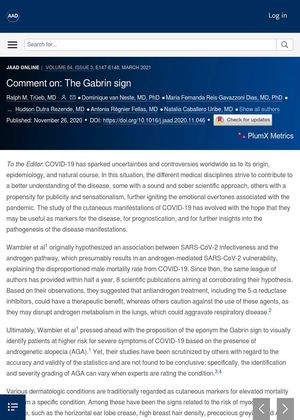Comment on: The Gabrin Sign
November 2020
in “
Journal of The American Academy of Dermatology
”

TLDR The document suggests that more research is needed to confirm if baldness can indicate a higher risk of severe COVID-19 in men.
The document discusses the hypothesis by Wambier et al. that there is an association between SARS-CoV-2 infectiveness and the androgen pathway, which could explain the higher male mortality rate from COVID-19. They suggested that antiandrogen treatment, including 5-α reductase inhibitors, could have therapeutic benefits. They also proposed the "Gabrin sign" to identify patients at higher risk for severe COVID-19 symptoms based on the presence of androgenetic alopecia (AGA). However, the accuracy and validity of their studies have been questioned, particularly the identification and severity grading of AGA. The document also mentions that other risk factors for severe COVID-19 in younger men without pre-existing medical conditions are being explored, such as loss-of-function variants of X-chromosomal TLR7 associated with impaired type I and II interferon responses. The authors suggest that before establishing an eponym like the Gabrin sign, confirmation of the observation by an independent party of investigators is needed.





